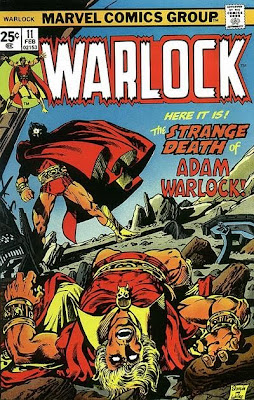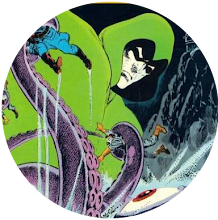The first person who really existed is someone called Adolf Hitler who puts in a blink-and-you'll-miss-him appearance in the tale of a Nazi major out to discover the ultimate torture, one that can break the spirit of any man. When that major's implicated in the plot to assassinate Hitler, he's subjected to his own methods, only to discover the ultimate torture is a thing called Hope. It looks like those Greeks knew of what they spoke when they claimed Hope was the only evil left behind in Pandora's Box.
Next up, Lawrence of Arabia has a very dull adventure that mostly involves him saying "Allah" a lot and referring to everyone in sight as "Brother" in between blowing things up. He keeps following around what looks like a fox but writer Robert Kanigher keeps insisting is a jackal. Being drawn by Alfredo Alcala, the story's inevitably a thing of visual beauty but it's somewhat uninvolving and the fact that Lawrence seems to be killing people for the sake of it makes it hard to feel any great empathy for him. There's also the question of the ethicality of creating fictional tales around real people.
Our final real person is King Edward the Third, who spends the first part of the closing tale having a barney with a bunch of Frenchman in Crécy.
I could stun you here with my knowledge of Edward the Third but frankly I don't have a clue who he was or what he did, so I'd best draw a veil over that whole subject and say the second half of the tale fast-forwards to the First World War where a bunch of under-fire Tommies are rescued from the Germans by the giant ghosts of Edward the Third's bowmen. As a story, this clearly owes something (everything) to Arthur Machen's myth of the Angels of Mons, instantly planting in the mind of any true comic fan the only question that matters; "Who'd win a fight between the Phantom Bowmen of Crécy and the Angels of Mons?"
Overall, it's not a great issue, in fact I'd say it's noticeably sub-par. The first story's the only one that really works, the TE Lawrence tale fails completely and, Eddy the Third aside, the Bowmen tale has no actual named characters, meaning it feels more like an anecdote than a full-blown story.
As always, the letters page finds editor Joe Orlando pleading with readers to send him some letters so he'll actually have something to print. War may be hell but it seems it's nothing beside the nightmare that is editing Weird War Tales.































































































